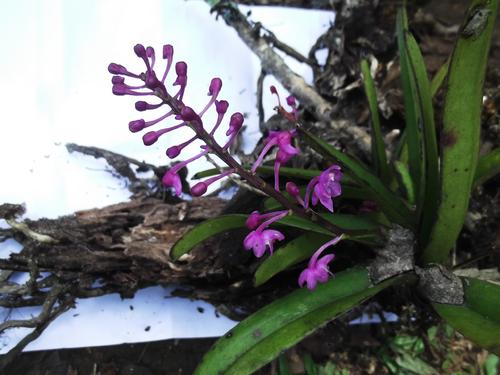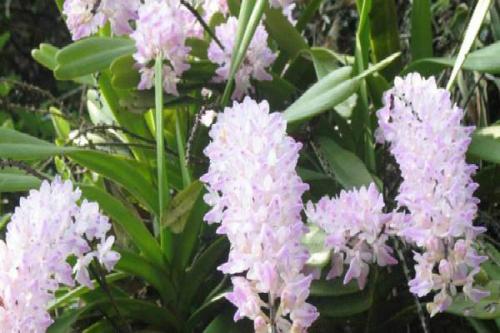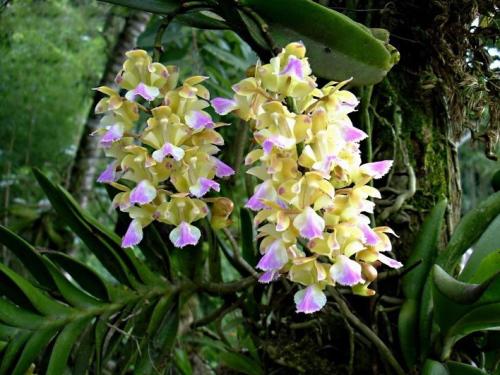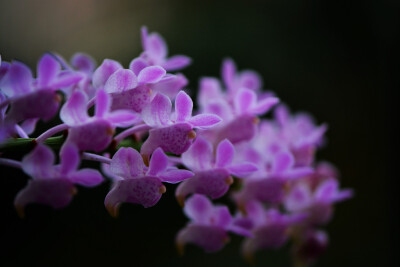Aerides odorata profile
Written by Maggie
Sep 26 2021

Aerides Odorata stalks are thick and stout. Aerides Odorata leaves are thickly leathery, broadly banded, 15-20 cm long and 2.5-4.6 cm wide, apex obtuse and 2-lobed unequally, base articulated and sheathed. Racemes are pendulous, subequal or longer than leaves, densely flowered; Flowers are large, spreading, ca. 3 cm in diam., aromatic, white to pinkish; Petals are subelliptic, slightly smaller than sepals, apex obtuse, base narrow;
Aerides Odorata picture

Morphological characteristics of Aerides Odorata
Stems
Aerides Odorata has thick stalks.
Leaf
Leaves of aerides odorata are thick and leathery, broadly banded, 15 -- 20 cm long and 2.5 -- 4.6 cm wide, apically obtuse and equilateral 2-lobed, with joints and sheaths at base.
Flowers
Aerides Odorata racemes pendulous, subequal or longer than leaves, densely bearing many flowers;Inflorescence stalk stout, sparsely with a few scaly sheaths; Flowers are large, spreading, ca. 3 cm in diam., aromatic, white to pinkish; Bracts are broadly ovate, much shorter than stipitate ovary, apex obtuse; Middle sepals of Aerides Odorata are elliptic, ca. 1 cm long and 8 mm wide, apex obtuse, with 4-5 main veins; Lateral sepals basically adhere to spirostacea, broadly ovate, 1.2 cm long and 9 mm wide, apex obtuse, with 4 -- 5 main veins.
Petals
Petals of Aerides Odorata are subelliptic, slightly smaller than sepals, obtuse at the apex, narrow at the base; Labellum inserted at end of stamen column foot, 3-lobed; Lateral lobes are erect, large, obovate-cuneate, ca. 1.5 cm long, apex 1 cm wide, apex obtuse, upper margin irregularly toothed; Middle lobes of Aerides Odorata are narrowly oblong, 1.2 cm long, ca. 3 mm wide, apex 2-lobed; Spur narrowly angular, ca. 1 cm long, curved forward; Stamina stout, ca. 5 mm long, with stamina legs ca. 9 mm long.
Aerides Odorata's ecological habits
Aerides Odorata usually grows on the mountainside wall of deep mountains and valleys, sloping slopes or stone crevices with good water permeability and water retention, near sparse mountain grasses, and under the shade of secondary mixed wood forests. Or have shade, sunshine time is short or only the place where the star leaks light. Where the air is moist and can circulate, it is sometimes born on the side of mountain streams and cliffs.
Aerides Odorata is best planted in a well-ventilated environment. Aerides Odorata likes shade, avoid direct sunlight, like wet, avoid dry, 15℃ to 30℃ most suitable for growth. Poor growth above 35℃. Cold temperature below 5℃ will affect its growth, when the Aerides Odorata is often in a dormant state. If the temperature is too high and the sun is exposed to the sun, the leaves will burn or scorch within a day or two.If the temperature is too low and does not transfer into the house in time, there will be frostbite.
Aerides Odorata is a fleshy root, suitable for humus-rich sandy loam, drainage must be good, should choose leaf rot soil or humus-rich mountain soil. Slightly acidic loose soil or soil containing iron, pH value of 5.5-6.5 is appropriate.
Aerides Odorata's way of propagation
Division
In spring and autumn can be carried out, generally every three years a plant. Any plant with strong growth and dense pseudo corms can be divided, and at least 5 connected pseudo corms should be stored in each cluster after division. Before planting Aerides Odorata, reduce irrigation water, so that the basin soil is more than. After planting, cover the bottom hole of the pot with broken tiles, then lay coarse stones, which account for 1/5 to 1/4 of the depth of the pot, then put coarse-grained soil and a small amount of fine soil, and then plant with sandy loam rich in humus. Planting depth to the false corm just buried in the soil strength, basin edge to leave 2 cm along the mouth, spread Cui Yun grass or fine stones, finally pouring permeable, shady place for 10-15 days, keep the soil moist, gradually reduce watering, normal maintenance.
Seed propagation
The seed of Aerides Odorata is very thin, and there is only one incomplete embryo in the seed, so its germinating ability is very low. Besides, the seed coat is not easy to absorb water, so it cannot germinate by conventional sowing methods. Therefore, Aerides Odorata fungus or artificial medium is needed to supply nutrients for germination. Planting fruit had better choose not cracking, surface with 75% alcohol after sterilization, remove the seeds, soaking with 10% sodium hypochlorite for 5-10 minutes, take out three times with sterile water rinse again can play in the cultivation of the bottle containing medium, and dark in the pure, the temperature about 25 c, stirring and then moved to the light that can form the original bulb. From sowing to transplanting, it takes half a year to a year. Tissue culture has been successful and can be propagated by this method where conditions permit.

Disease and pests control of Aerides Odorata
Disease control
Southern blight
Mostly in the rainy season. At the beginning of the disease, the leaf base is full of white mycelium. Cause root rot. Prevention and control method: remove fungus basin soil, sprinkle on pentachloronitrobenzene powder or lime. Radical cure method: pay attention to ventilation and light, basin soil drainage is good. Serious diseases Aerides Odorata are burned.
Anthrax
It occurs all the year round, and is more prevalent in hot and rainy seasons, especially in orchid. The spots first extend from the tip of the leaf to the rhizome, brown at the beginning, and then gradually expand and increase, there are many dry black spots, which lead to the death of the whole Aerides Odorata in serious cases. Prevention and control methods: in addition to actively change the environmental conditions, in the onset period, can be used first with 50% methyl tobujin wettable powder 800-1500 times the liquid spray treatment, once every 7-10 days;Then supplemented with 1% equivalent Bordeaux liquid, once every half a month, continuous spray 3-5 times.
Pest control
Scale insects
Commonly known as "lice". They propagate fastest in conditions of high temperature, humidity and poor air flow. It can be sprayed with 1% diethoate oxide or 1500 times 50% mala sulfur during incubation period. If the number of pots is not much, it can also be brushed manually.
Aerides Odorata's distribution area
Aerides Odorata is born on tree trunks in mountain forests.
Aerides Odorata is produced in Guangdong, western Yunnan (Yingjiang), China. Aerides Odorata is widely distributed from tropical Himalayas to Southeast Asia.
The type specimen of Aerides Odorata was collected from Guangdong, China.
Aerides Odorata uses
Aerides Odorata is born on a tree trunk in a mountain forest, and clusters of flowers hang from the tree trunk, which is very beautiful to watch!
How to grow and care for Aerides Odorata
Soil
Since Aerides Odorata has fleshy roots, sandy soil with humus and good drainage is preferred. We can choose the mountain soil containing more humus or leaf rot soil.
Fertilization
In its growth and development period, adhere to every ten days for a foliar spray fertilizer, can make Aerides Odorata grow exuberantly. This fertilization method can not only supplement the plant nutrition through the absorption of leaves, but also avoid the damage caused by the direct contact of fertilizer with the root. Fertilizer can use aloe vera liquid or natural organic fertilizer.
Watering
Watering is usually carried out in the evening or early morning, do not water at noon and pour-off. Watering needs to be watered thoroughly, should be in accordance with the "dry watering, wet stop" principle, keep the soil suitable partial dry. In its growth boom period, the summer water shortage is easy to lead to poor growth, needing eight points dry, two wet.
The temperature
Aerides Odorata likes warmth and grows well in the environment of 15-28℃. In winter, the room temperature should be kept above 8℃ before it can be safely overwintered.
In the basin
Planting is usually carried out in spring and in autumn. Aerides Odorata planting needs to wash the roots. The roots of the plants are immersed in water and gently washed with a brush or an old toothbrush. Cut away the yellow leaves, residual leaves, broken and rotten black roots, pay attention not to hurt the buds, and then place them in a cool and ventilated place to air and sun slightly. When the roots turn white and fine wrinkles are soft, they can be implanted in the basin.

Latest Updated
- Benefits of Bugleweed - 7 Science-backed Health Benefits
- Bugleweed Dangers & Side Effects - Is It Poisonous?
- How to Plant Evergreen Trees - What You Should Know
- When to Plant Evergreens - Grow Guide for Evergreen Trees
- 12 Wonderful Evergreen Shrubs for Your Garden
- 12 Popular Evergreen Plants with Pictures for Beginners
- When And How To Prune A Lilac Bush Like a Pro
- How to Grow & Care for Lilac Vine (Hardenbergia Violacea)
- Japanese Lilac Tree (Syringa Reticulata) Care & Propagation Guide
- Shumard Oak Pros and Cons - What to Know
Popular Articles
- Winter maintenance of Antirrhinum Majus
- How to Grow Terminalia Mantaly Tree
- How to Grow and Care for Crossostephium Chinense
- How to grow Antirrhinum Majus in spring
- Peristeria Elata (Dove Orchid) Profile: Info & Care Guide
- Underwatered Snake Plant (Sansevieria Trifasciata) - Signs And How To Fix
- How to Care for Brazilian Jasmine Plant (Mandevilla Sanderi)
- How to Grow & Care for Graptopetalum Purple Delight in Summer
- Rosa Chinensis (China Rose): Plant Growing & Care Tips
- How to Care for Baby Sun Rose (Aptenia Cordifolia)